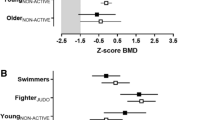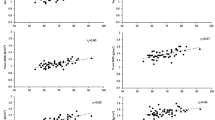Abstract
The bone response to exercise is site-specific and load-dependent. Recent evidence suggests that an inverse relationship may exist between loaded and unloaded sites, such that the former may benefit at the expense of the latter. The present study examined this possibility in 48 males (21 water polo players, 12 handball players, and 15 sedentary controls). Water polo and handball are alike with respect to the active loading of the upper limbs during overhead throwing; however, the weight-supporting environment of water polo removes the weight-bearing effect from the lower limbs. Bone mineral content (BMC), bone projected area (Ap), and areal bone mineral density (aBMD) of the total body and of various subregions were determined by dual-energy X-ray absorptiometry. After adjusting for age, height, and weight, water polo players had higher arms BMC, Ap, and aBMD (by 22.2, 11.1, and 10.5%, respectively; P < 0.05), but lower legs aBMD (−6.3%; P < 0.05) relative to controls. On the contrary, compared to controls, handball players had higher BMC (from 11.8 to 24.3%), Ap (from 5.2 to 11.7%), and aBMD (from 6.4 to 11.9%) for the total body at all sites. Water polo athletes had increased arms and decreased legs aBMD ratios (regional-to-total) than either handball players or sedentary subjects (P < 0.001). Water polo is associated with an apparent redistribution of bone mass and density from the lower to the upper limbs, with no major effects on the rest of the body.

Similar content being viewed by others
References
ACSM (1995) American college of sports medicine position stand. Osteoporosis and exercise. Med Sci Sports Exerc 27:i–vii
Anderson JJB, Stender M, Rondano P, Bishop L, Duckett AB (1998) Nutrition and bone in physical activity and sport. In: Wolinsky I (eds) Nutrition in exercise and sport. CRC Press, Boca Raton, pp 219–244
Andreoli A, Monteleone M, Van Loan M, Promenzio L, Tarantino U, De Lorenzo A (2001) Effects of different sports on bone density and muscle mass in highly trained athletes. Med Sci Sports Exerc 33:507–511
Bailey DA, Faulkner RA, McKay HA (1996) Growth, physical activity, and bone mineral acquisition. Exerc Sport Sci Rev 24:233–266
Blimkie CJR, Chilibeck PD, Davison KS (1996) Bone mineralization patterns: reproductive endocrine, calcium, and physical activity influences during the life span. In: Bar-Or O, Lamb DR, Clarkson PM (eds) Exercise and the female–a life span approach. Cooper Publishing Group, Carmel, pp 73–145
Block JE, Friedlander AL, Brooks GA, Steiger P, Stubbs HA, Genant HK (1989) Determinants of bone density among athletes engaged in weight-bearing and non-weight-bearing activity. J Appl Physiol 67:1100–1105
Bouxsein ML, Marcus R (1994) Overview of exercise and bone mass. Rheum Dis Clin North Am 20:787–802
Carter DR, Bouxsein ML, Marcus R (1992) New approaches for interpreting projected bone densitometry data. J Bone Miner Res 7:137–145
Chilibeck PD, Sale DG, Webber CE (1995) Exercise and bone mineral density. Sports Med 19:103–122
Ducher G, Prouteau S, Courteix D, Benhamou CL (2004) Cortical and trabecular bone at the forearm show different adaptation patterns in response to tennis playing. J Clin Densitom 7:399–405
Frost HM (2003) Bone’s mechanostat: a 2003 update. Anat Rec 275A:1081–1101
Ginty F, Rennie KL, Mills L, Stear S, Jones S, Prentice A (2005) Positive, site-specific associations between bone mineral status, fitness, and time spent at high-impact activities in 16- to 18-year-old boys. Bone 36:101–110
Heaney RP, Abrams S, Dawson-Hughes B, Looker A, Marcus R, Matkovic V, Weaver C (2000) Peak bone mass. Osteoporos Int 11:985–1009
Karlsson M (2002) Is exercise of value in the prevention of fragility fractures in men? Scand J Med Sci Sports 12:197–210
Kelley GA, Kelley KS, Tran ZV (2000) Exercise and bone mineral density in men: a meta-analysis. J Appl Physiol 88:1730–1736
Layne JE, Nelson ME (1999) The effects of progressive resistance training on bone density: a review. Med Sci Sports Exerc 31:25–30
Lee EJ, Long KA, Risser WL, Poindexter HB, Gibbons WE, Goldzieher J (1995) Variations in bone status of contralateral and regional sites in young athletic women. Med Sci Sports Exerc 27:1354–1361
Lima F, De Falco V, Baima J, Carazzato JG, Pereira RM (2001) Effect of impact load and active load on bone metabolism and body composition of adolescent athletes. Med Sci Sports Exerc 33:1318–1323
Morel J, Combe B, Francisco J, Bernard J (2001) Bone mineral density of 704 amateur sportsmen involved in different physical activities. Osteoporos Int 12:152–157
Nevill AM, Burrows M, Holder RL, Bird S, Simpson D (2003a) Does lower-body BMD develop at the expense of upper-body BMD in female runners? Med Sci Sports Exerc 35:1733–1739
Nevill AM, Holder RL, Stewart AD (2003b) Modeling elite male athletes’ peripheral bone mass, assessed using regional dual x-ray absorptiometry. Bone 32:62–68
Ralston SH (2002) Genetic control of susceptibility to osteoporosis. J Clin Endocrinol Metab 87:2460–2466
Risser WL, Lee EJ, LeBlanc A, Poindexter HB, Risser JM, Schneider V (1990) Bone density in eumenorrheic female college athletes. Med Sci Sports Exerc 22:570–574
Snow-Harter C, Marcus R (1991) Exercise, bone mineral density, and osteoporosis. Exerc Sport Sci Rev 19:351–388
Suominen H (1993) Bone mineral density and long term exercise. An overview of cross-sectional athlete studies. Sports Med 16:316–330
Taaffe DR, Suominen H, Ollikainen S, Cheng S (2001) Calcaneal bone mineral and ultrasound attenuation in male athletes exposed to weight-bearing and nonweight-bearing activity. A cross-sectional report. J Sports Med Phys Fitness 41:243–249
Acknowledgements
This study was supported by the Greek Swimming Federation. We would like to thank Silia Sidossi, research assistant, for her help in data collection, as well as the subjects for their interest and participation in the study.
Author information
Authors and Affiliations
Corresponding author
Rights and permissions
About this article
Cite this article
Kavouras, S.A., Magkos, F., Yannakoulia, M. et al. Water polo is associated with an apparent redistribution of bone mass and density from the lower to the upper limbs. Eur J Appl Physiol 97, 316–321 (2006). https://doi.org/10.1007/s00421-006-0201-1
Accepted:
Published:
Issue Date:
DOI: https://doi.org/10.1007/s00421-006-0201-1




